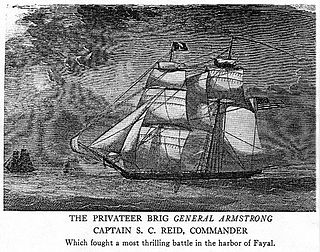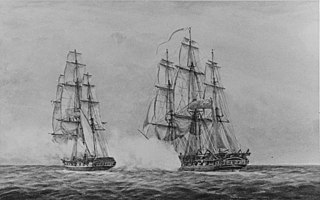Sir John Sherbrooke was a successful and famous Nova Scotian privateer brig during the War of 1812, the largest privateer from Atlantic Canada during the war. In addition to preying on American merchant ships, she also defended Nova Scotian waters during the war. After her conversion to a merchantman she fell prey to an American privateer in 1814. She was burnt to prevent her reuse.

HMS Gorgon was a 44-gun fifth-rate two-decker ship of the Adventure class of 911 tons, launched at Blackwall Yard in 1785 and completed as a troopship. She was subsequently converted to a storeship. She also served as a guardship and a hospital ship at various times before being broken up in 1817.

HMS Belvidera was a Royal Navy 36-gun Apollo-class frigate built in Deptford in 1809. She saw action in the Napoleonic Wars and the War of 1812 and continued a busy career at sea into the middle of the 19th century. In 1846 she was reduced to harbour service, in 1860 she became a receiving ship, and she was finally disposed of in 1906.
USS Gallatin was a post-Revolutionary War sailing vessel that the U.S. Department of the Treasury purchased at Norfolk, Virginia, for the United States Revenue-Marine in December 1807. An explosion on board destroyed her in 1813.

Rhin was a 40-gun Virginie-class frigate of the French Navy launched in 1802. She was present at two major battles while in French service. The Royal Navy captured her in 1806. Thereafter Rhin served until 1815 capturing numerous vessels. After the end of the Napoleonic Wars she was laid up and then served as a hospital for many years. She was finally broken up in 1884.

General Armstrong was an American brig built for privateering in the Atlantic Ocean theater of the War of 1812. She was named for Brigadier General John Armstrong, Sr., who fought in the American Revolutionary War.

Rossie was a schooner launched at Baltimore in 1807. At the outbreak of the War of 1812 she became a privateer, operating under a letter of marque. She made two voyages, the first as a privateer, and the less successful second as a letter of marque. The British captured her in January 1813.
Atlas was built in Souths Shields by Temple and launched in 1801 for Temple. She made two voyages transporting convicts from Ireland or England to Port Jackson. On the first voyage she carried cargo for the British East India Company (EIC). On the second she sailed to Bengal after delivering her convicts to New South Wales and was wrecked off India in 1820 while on her way back to Britain.
Hercules was a sailing ship built in 1801 at South Shields, England. She made one trip transporting convicts to Port Jackson. She made two trips for the British East India Company (EIC), and was homeward bound from the second of these when the French privateer Napoleon captured her off the Cape of Good Hope.

Holkar was an American privateer active during the War of 1812 that made several captures. HMS Orpheus destroyed her on 11 May 1813.
Francis and Eliza was a brig built in 1782 upon the River Thames, England. An American privateer captured her in 1815 while she was transporting convicts from Ireland to Port Jackson, New South Wales, and then released her. She was condemned in 1819 by a United States court for having violated U.S. law, and was sold in 1820.
HM Colonial brig Kangaroo, was a brig built at Bideford, England in 1811 or 1812. She belonged to the British Royal Navy's Transport Board and was based at Port Jackson. There she made voyages for the colonial government along the east coast of Australia with goods and troops. She made one voyage to Ceylon for merchandise and transporting military convicts from Ceylon to Australia. She returned to England in 1817 and the Navy sold her in 1818.

Hibernia, of 435 tons, was launched at Cowes in 1810. She operated as a letter of marque West Indiaman and in 1814 engaged in a noteworthy single-ship action with the American privateer Comet during which she repelled her more heavily-armed attacker. In 1819 she transported convicts to Van Diemen's Land. She was last listed in 1840.
Hebe, built in Hull in 1810, made two notable voyages, one voyage as an extra ship for the British East India Company (EIC), and one voyage transporting convicts to New South Wales. In between, an American privateer captured Hebe, but the British Royal Navy recaptured her. Hebe was wrecked in 1833.

Morley was a merchantman launched in 1811 at Deptford as a West Indiaman. In 1813 she was under contract to the Transport Board when she captured an American vessel, which capture gave rise to an interesting court case. In early 1815 an American letter of marque captured, plundered, and released her. She then made six voyages to Australia transporting convicts. On her fifth voyage she introduced whooping-cough to Australia. After her sixth voyage she sailed to China and then brought a cargo back to England for the British East India Company (EIC). She continued to sail to Australia and elsewhere and is last listed in 1855.

HMS Narcissus was the lead ship of the Royal Navy Narcissus-class 32-gun fifth-rate frigate, launched in 1801. She participated in the War of 1812.
Lion was launched in 1803 in Turkey, or 1802 in Spain. British owners acquired her in 1809, probably by purchase of a prize. She was a merchantman and letter of marque. She captured an American privateer in a notable single-ship action in 1813, some months before Lion was wrecked in 1813.
Several ships have been named Emu for the emu:
Emu (sometimes "His Majesty's armed brig Emu", was a merchant ship built at Dartmouth in 1813. The British government engaged her to go out to New South Wales to serve the colony there. She spent about a year transporting people and supplies between New South Wales and Van Diemen's Land before the colonial government sent her back to England in 1816. On her way she stopped at the Cape Colony where she was wrecked in 1817.
Emperor Alexander was launched in 1813 at Chepstow. Relatively early in her career she made two voyages to India and the East Indies under a license from the British East India Company (EIC). On her return she became a West Indiaman, and also sailed to South America, North America, and the Baltic. She carried immigrants to Quebec and transported convicts to Tasmania. She was condemned in 1835 following damage at sea on her way to the Cape and India.








